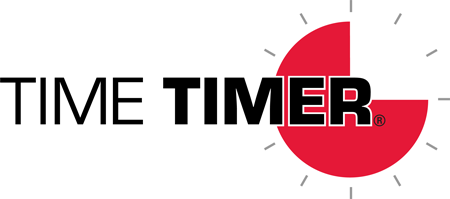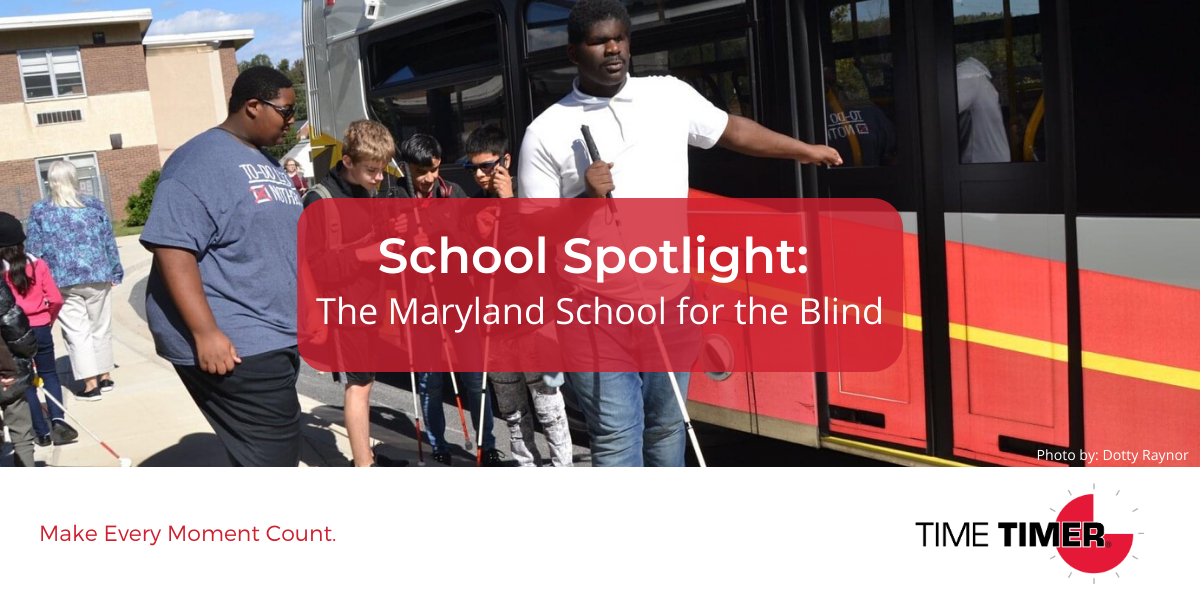We’re huge fans of educators and all the places where they work! With many schools currently closed for in-person learning around the world due to COVID-19, there has been renewed (and much deserved!) appreciation for educators and everything they do to serve our young people. We’re pleased to share the third post in our School Spotlight series featuring amazing schools. We’d like to shine a bright light on the Maryland School for the Blind in Baltimore. It serves students from infancy to age 21 who are blind or visually impaired, including some with multiple disabilities. To celebrate National Occupational Therapy Month, we talked with an Occupational Therapist at MSB, Deb Nikkila. Read on to find out what makes the school so special, how they are managing distance learning, and Nikkila’s top tips for parents of a child with visual impairment.
Have a school you’d like to see featured? We’d love to hear from you! Email support@timetimer.com.
The School: The Maryland School for the Blind
What It Is: The Maryland School for the Blind (MSB) is a 501 (c) 3 non-profit private day and residential school serving students from age 3 to 21 who are blind or visually impaired, including some with multiple disabilities. Approximately 95% of the 225 students served in the day school and residential programs have intellectual, sensory, behavioral, and physical disabilities as well as health challenges in addition to their visual impairment. As a statewide resource center, MSB also serves 65% of the 2,000 students identified as blind or visually impaired throughout all 24 Maryland jurisdictions.
The Newcomer Building at MSB
“Students have a right to receive an education that meets their needs,” says Deb Nikkila, Occupational Therapist at MSB. “Every kid is different, there is no prescribed way of doing things. It’s all about deciphering the code and what works for the student. It takes time, and it’s a team process.” Staff at MSB include Occupational Therapists, Physical Therapists, teachers, social workers, and more, who are in constant collaboration with each other on best strategies and how they can best support each student’s learning needs.
The Goal: “We are striving for the greatest level of independence possible for the capabilities of each individual. Independence doesn’t mean doing everything on your own, it means having autonomy to do things for yourself, to be able to participate in your life. Students may need help washing their hair, or getting the right temperature for a bath, they may not do it all, but they can do the rest. It’s about autonomy and self-determination,” says Nikkila.
MSB provides outreach, educational and residential services for students to reach their fullest potential by preparing them to be as successful, independent and well-rounded contributing members of their communities as possible.
Deb Nikkila with a Student Exploring During the Beeping Easter Egg Hunt
Photo By: Dotty Raynor
How It Works: Like all school programs, each student has a mandated Individualized Education Plan (IEP) tailored to their learning needs. MSB’s programming includes general education subjects and, in addition, special instruction in the disability-specific areas of the Expanded Core Curriculum that includes braille, orientation and mobility, career education and independent living skills.
“That assessment drives their needs and progress. What are the ‘holes”? What are the priorities? What is going to make this student the most autonomous they can be? Is it most important that they know how to make a PB&J or to be able to brush their teeth? That they know geometry or that they can make a cash transaction at a store?” says Nikkila.
Exit goals for students may be to earn a high school diploma or a certificate of attendance at graduation, or to return to their local school systems with increased skill levels essential for successful reintegration and academic achievement.
Distance Learning During the COVID-19 Pandemic: MSB is currently offering distance learning due to the COVID-19 related school closures. Nikkila shares that while it has been quite the experience, it is one she and her colleagues have taken on with enthusiasm. For example, Nikkila is using Google Classroom for the early learning program (students aged 3 to 6) to teach songs that use big motor movements that parents or school professionals can go through with their children. She says, “how we’re presenting is different, but what we’re doing is the same.” And it’s working, as Nikkila has received positive responses from families working by video.
Success Stories: There are many! “The kids are inspiring and the ability to be so multidisciplinary is so rewarding,” says Nikkila. She explains that MSB’s “mission is to help our students reach their fullest potential which means the students are immersed in a community that believes in what they can do. The MSB campus gives students a sense of stability and with that they are more prepared to grow and develop. We celebrate small achievements and big achievements alike.” For example, Nikkila shared a story of using the Time Timer for a student who was inattentive to mealtimes. By using the timer to show time elapsing through the red disk, the student now happily eats in 30 minutes. Many students with a visual impairment can see the high contrast of the Time Timer, and it is also used by school professionals to help students learn various routines, offer structure for break or play time, or as a tool for students to ‘learn to learn’.
MSB Graduation Speech
Photo By: Dotty Raynor
What Students Think: “Students really like school!” says Nikkila. “The MSB programs are highly tailored to the learning needs of our students with visual impairment and other learning disabilities. We provide the structure, predictability, and repetition they need to be successful learners. Our teachers build lasting relationships with students and their families and I think the kids feel that. For the most part, I believe students at MSB feel valued and heard.”
Why it Matters: “One of the greatest determinants of success is mindset; we are a product of what we think we can be,” says Nikkila. “At MSB we emphasize working together as one team to be everything you can be academically and socially. MSB puts great effort into making sure students have a broad life experience. Students can try out for sports including soccer, swimming, wrestling, cheerleading, goalball, and track. We organize special events throughout the school year such as snow ski trips, participating in the Maryland Savage Race, on-stage play productions, chorus performances, percussion club, and robotics club, just to name a few. The students have opportunities at MSB and a level of support that makes it a feel good place to be, and the families are grateful that their child is given a chance.”
Inspiration to action: How can parents help a child with visual impairment? Here are Occupational Therapist Deb Nikkila’s top tips:
Slow down and narrate life: “The most important thing a parent of a visually impaired child could do is describe the world for them. 80% of what a sighted person learns over their lifetime is acquired through vision. For example, when you make sugar cookies, explain how the butter and sugar needs to be creamed together before adding the dry ingredients. What does "creamed" mean? Take the time to let the child feel the butter and sugar mixture after 30 seconds of mixing and again after 3 minutes of mixing… now they can feel the difference between a gritty mixed butter/sugar and a fluffy creamed butter/sugar. Without any vision at all they now have the same knowledge as a sighted child obtained by watching the process. These moments of incidental learning are constantly happening for a sighted person and they don't even know they have learned something. Providing a visually impaired learner with as much detail as possible through words, sounds, and touch helps them build vocabulary, develop concepts, understand social interactions, and perceive the environment.”
Let the student do it themselves next time: “The second most important thing a parent of a visually impaired child can do is let the child cream the butter the next time. They have been given the knowledge, now expect them to do something with it. Everyone needs a bit of help sometimes, but doing too much for a blind person does not help them in the long run. Instead, it magnifies their disability and intensifies a disconnect between the child and the world.”
Girl's Goalball Athletes Taking a Break
Photo by: The Maryland School for the Blind
Like this post? Check out our other school spotlight posts here.
---
Jodie Martin is a freelance writer specializing in health and wellbeing, lifestyle, and parenthood. She is also an E-RYT 500 Registered Yoga Teacher, Ayurveda Yoga Specialist, and Three Wisdom Traditions wellness coach. Jodie lives in Asheville, NC.





